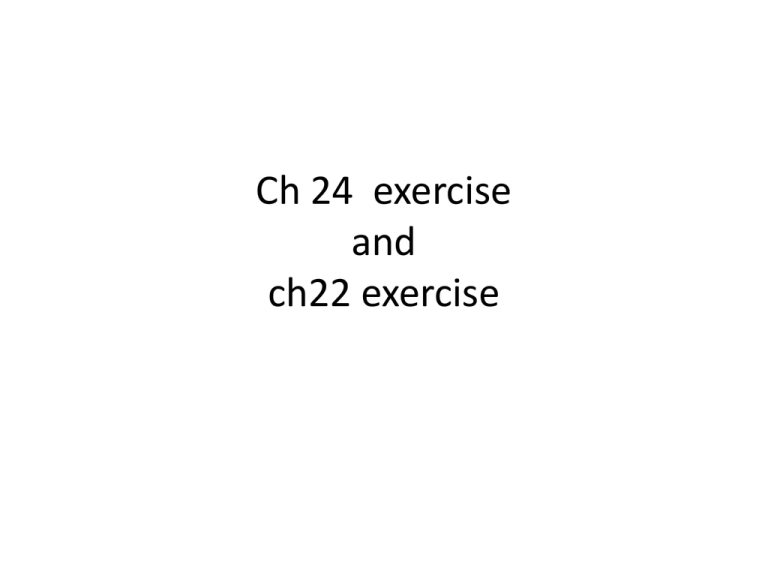Ch 24and ch22 exercise
advertisement

Ch 24 exercise and ch22 exercise 21. A user is connected to a Frame Relay network through a T-l line. The granted CIR is 1 Mbps with a Bc of 5 million bits/5 s and Be of 1 million bits/5 s. a. What is the access rate? The access rate is the rate of T-1 line (1.544 Mbps) that connects the user to the network. Obviously, the user cannot exceed this rate. b. Can the user send data at 1.6 Mbps? The user data rate cannot exceed the access rate, the rate of the T-1 line that connects the user to the network. The user should stay below this rate (1.544 Mbps). c. Can the user send data at 1 Mbps all the time? Is it guaranteed that frames are never discarded in this case? The CIR is 1 Mbps. This means that the user can send data at this rate all the time without worrying about the discarding of data. d. Can the user send data at 1.2 Mbps all the time? Is it guaranteed that frames are never discarded in this case? If the answer is no, is it guaranteed that frames are discarded only if there is congestion? The user can send data at the rate of 1.2 Mbps because it is below the access rate. However, the user sends 6 million bits per 5 seconds, which is above Bc (5 million per 5 seconds), but below Bc+Be (6 million per 5 seconds). The network will discard no data if there is no congestion, but it may discard data if there is congestion. Cont Q 21 e. Repeat the question in part (d) for a constant rate of 1.4 Mbps. The user can send data at the rate of 1.4 Mbps because it is below the access rate. However, the user sends 7 million bits per 5 seconds, which is above Bc and above Bc+Be (6 million per 5 seconds). In other words, the user rate is beyond its share. The network will discard some data to limit the data rate. f. What is the maximum data rate the user can use all the time without worrying about the frames being discarded? To be sure that the network never discard her data, the user should stay at or below CIR rate all the time, which means below or at 1 Mbps. g. If the user wants to take a risk, what is the maximum data rate that can be used with no chance of discarding if there is no congestion? If the user can accept possible data discarding in case of congestion, she can send at a higher rate if the number of bits is below Bc+Be (6 million per 5 seconds in this case). This mans that the user can send at 1.2 Mbps all the time if she accepts this risk. 22. In Exercise 21 the user sends data at 1.4 Mbps for 2 s and nothing for the next 3 s. Is there a danger of discarded data if there is no congestion? Is there a danger of discarded data if there is congestion? There is no risk of discarding at all because in 5 seconds, the user has sends 1.4 Mbps × 2 + 0 × 3 = 2.8 million bits in 5 seconds, which is below the Bc. 23. In ATM, if each cell takes 10 μs to reach the destination, what is the CTD? CTD is the average cell transfer delay. If each cell takes 10 μs to reach the destination, we can say that CTD = [(10 μs × n) / n] in which n is the total number of cells transmitted in a period of time. This means that CTD = 10 μs 24. An ATM network has lost 5 cells out of 10,000 and 2 are in error. What is the CLR? What is the CER? a. CLR is the average cell loss ratio. If the network has lost 5 cells out of 10,000, then CLR = 5 /10,000 = 1/2000. b. CER is the average cell error ratio. If two cells out of 10,000 are in error, then CLR = 2 /10,000 = 1/5000. CHAPTER 22 15. Find the topology of the network if Table 22.3 is the routing table for router R1. 24. A router has the following RIP routing table: Net 1 4 B Net 2 2 C Net 3 1 F Net 4 5 G What would be the contents of the table if the router received the following RIP message from router C? Net 1 2 Net 2 1 Net 3 3 Net4 7 Solution: a. add the cost between it self and router C: b. Update the routing table : 28. Draw the graphical representation of the autonomous system of Exercise 27 as seen by OSPF. Solution: 29. Which of the networks in Exercise 27 is a transient network? Which is a stub network? Transient networks: N1, N2, N5, and N6. Stub networks: N3 and N4 31. Does RPF actually create a shortest path tree? Explain. No, RPF does not create a shortest path tree because a network can receive more than one copy of the same multicast packet. RPF creates a graph instead of a tree. 32. Does RPB actually create a shortest path tree? Explain. What are the leaves of the tree? Yes, RPB creates a shortest path tree and its leaves are networks. However, the delivery of the packets are based on broadcasting instead of multicasting. 33. Does RPM actually create a shortest path tree? Explain. What are the leaves of the tree? Yes, RPM creates a shortest path tree because it is actually RPB with pruning and grafting features. The leaves of the tree are the networks.











